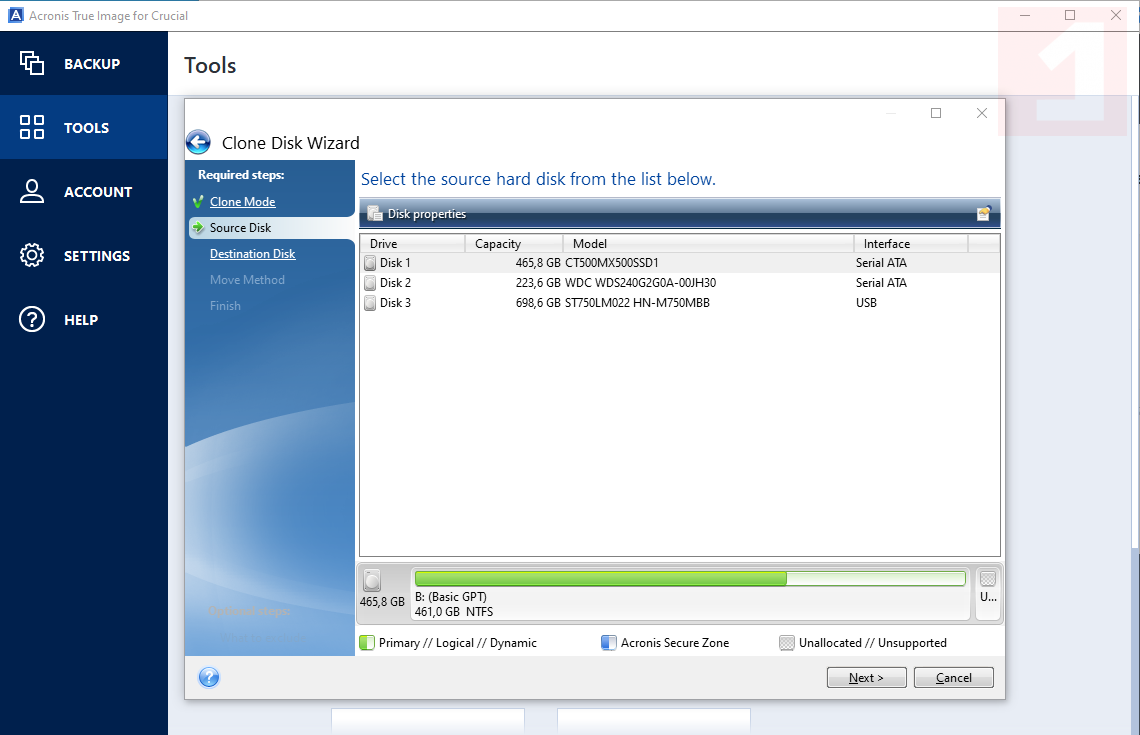

- ACRONIS TRUE IMAGE FOR CRUCIAL SOFTWARE
- ACRONIS TRUE IMAGE FOR CRUCIAL PC
- ACRONIS TRUE IMAGE FOR CRUCIAL FREE
Most of these tools feel “tacked on,” and I feel that most people would rather pay less to eschew some of these less important add-ons. For example, it comes with a system cleaner (which works fine, but doesn’t seem much better than Windows’ built-in tools), a ransomware monitor, and a “Try & Decide” feature that lets you make changes to your computer, then roll them back if you don’t like them. Those are all relatively useful, but it also has a lot of features that feel more like unnecessary padding. It even has a module that can back up your mobile devices and social media accounts.
ACRONIS TRUE IMAGE FOR CRUCIAL PC
Acronis can also clone one disk to another (which is useful if you’re upgrading to a new SSD or hard drive), build rescue disks (so you can fix your PC if it won’t boot), and convert your backups to a virtual hard drive for use in a virtual machine. Acronis also has a syncing tool, à la Dropbox/Google, for syncing files between machines.
ACRONIS TRUE IMAGE FOR CRUCIAL FREE
Some of those features are tangentially related to backups, like the “Archive” feature, which scans your hard drive for large files, and allows you to back up ones you rarely use to the cloud to free up space on your hard drive. For multiple machines, Acronis can get quite expensive, but it packs its program with extra features to make it more enticing. The value comparison depends highly on the number of machines you’re backing up, especially since they share the same pool of storage. Some throw in just 50GB of storage, and some like Backblaze are unlimited, and then others like IDrive start out at 2TB, so as you can see the options are kind of all over the map. It’s not the most expensive service I tested, but it is on the pricier side. If you need more space, add $20 per year for 500GB.Īny more than 500GB, and you’ll need a subscription to Premium, which adds a couple small features and allows for more space: 1TB for one computer at $100 per year, all the way up to 5TB for five computers at $320 per year, with many options in between.

If you’re backing up to the cloud, you’ll need a subscription to the Advanced version instead: for 250GB of space, you can pay $50 per year for one computer, $80 per year for three computers, or $100 per year for five computers.

ACRONIS TRUE IMAGE FOR CRUCIAL SOFTWARE
The Standard version is a one-time purchase of $60, which just gets you a license to the software that performs local backups. The structure of that subscription fee is a bit confusing at first, but the comparison wizard helps you choose what’s right for you. Acronis lets you back up to an external drive, a NAS, or to Acronis’ cloud servers (if you pay a monthly subscription fee). The backup process itself is dead simple, taking only a few clicks: you can back up certain folders and files, or back up an image of your entire machine. It explains every feature as you set it up, so you don’t have to click on "help" Icons to find out how anything works. Buttons are big and clear, your storage is color coded so you can see what’s taking up space, and Acronis’ many, many tools are organized neatly into sections away from the main backup window. Acronis True Image – Design, Features, and Pricingĭespite being an advanced backup tool, Acronis’ interface is very user-friendly. I thoroughly evaluated Acronis True Image along with several other leading packages based on three main criteria: pricing, features, and performance. Cloud backup options vary wildly in price and functionality, and are increasingly necessary for peace of mind and data security.


 0 kommentar(er)
0 kommentar(er)
